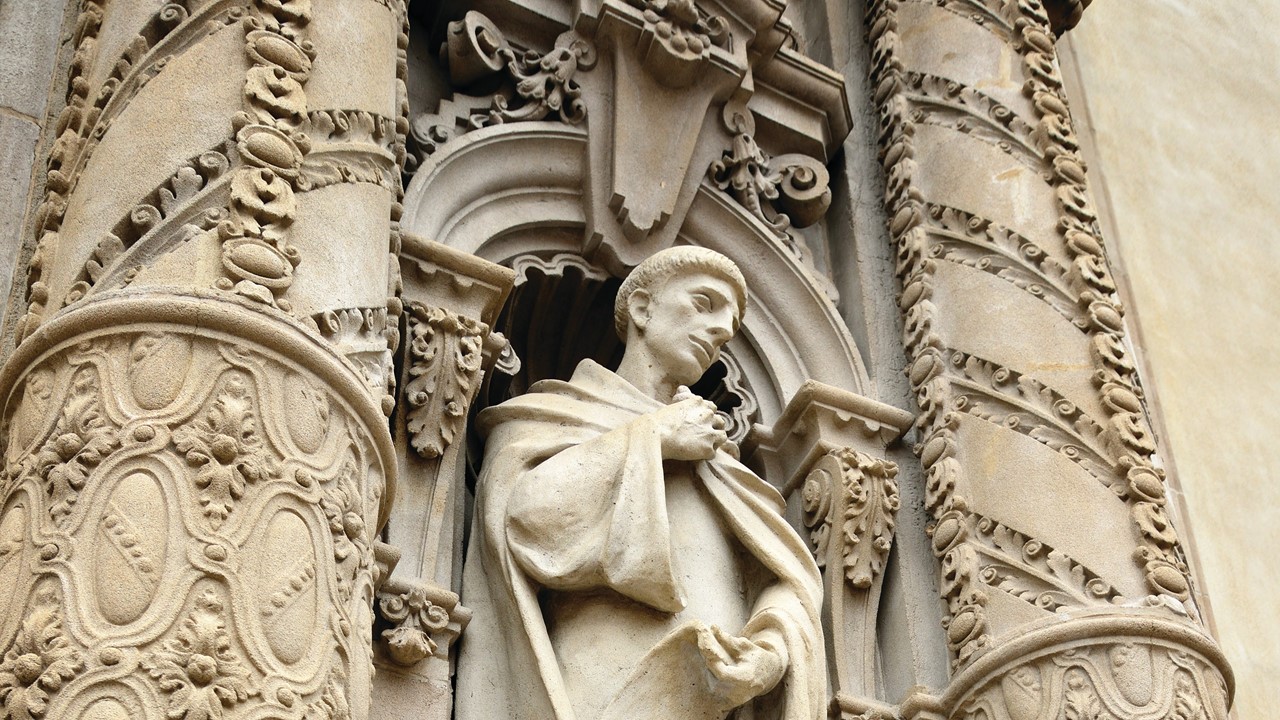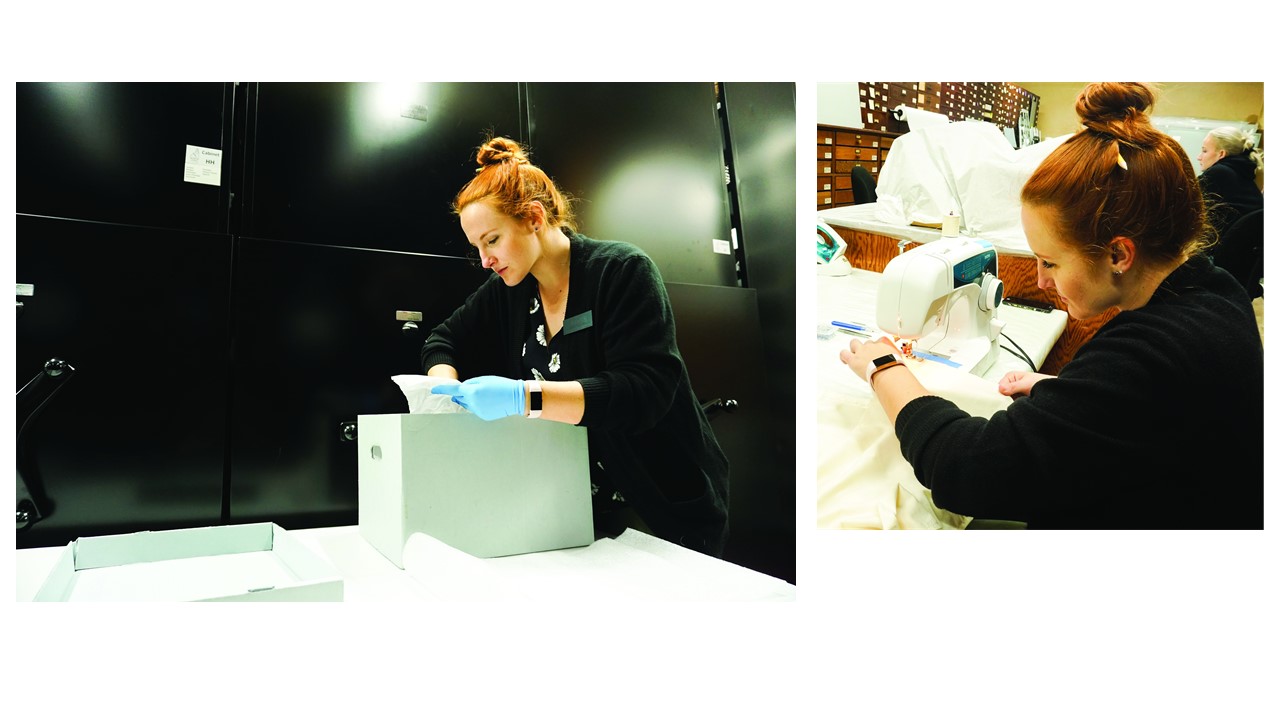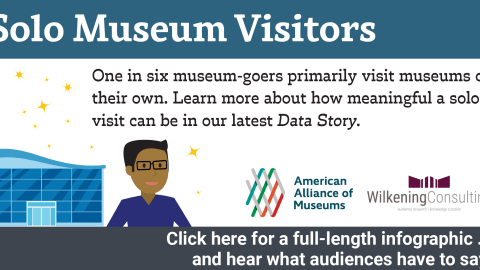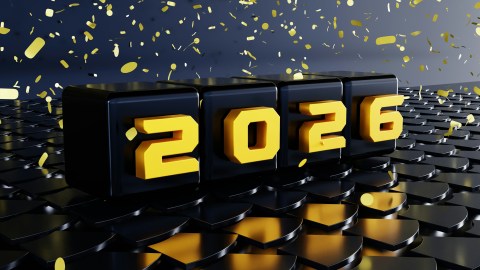
This article originally appeared in the January/February 2020 issue of Museum magazine, a benefit of AAM membership.
As museum professionals, we typically think of the word “curate” as a verb meaning “to collect, organize, and present” a group of items, often within the context of an exhibition. Another common meaning is “to be in charge of, or manage, a collection, gallery, or museum.” These definitions inform our industry’s approach, thinking, and identity surrounding curatorial practice. We see ourselves—and others see us—as expert in these activities.
The origins of the word, however, may suggest an alternative way of framing what we do. Derived from the Latin, “curate” is also a noun meaning “a spiritual guide” or “one responsible for the care of souls.” Within the context of its root verb “to cure”—meaning “to restore to health, or heal”—the curatorial endeavor takes on a far more holistic hue. When viewed through this lens, we have an opportunity to rethink the very nature of our expertise and the role we play in our communities.
Shifting the Paradigm
Such a rethinking has largely informed our work at the San Diego Museum of Man in Balboa Park, which sits on the ancestral homelands of the Kumeyaay Nation. For the past nine years, I have had the humbling honor of serving as CEO at this museum, founded in 1915 as part of the Panama-California Exposition. Our mission is “inspiring human connections by exploring the human experience.” We do that by sharing alternative narratives that challenge people’s assumptions and get them thinking, feeling, and even acting in new ways.
As an institution, we see pain and suffering in the world all around us. Whether that pain and suffering comes in the form of structural racism, colonial legacy, or other forms of oppression, we believe there is a path to healing, and we may have a part to play. Inspired by anthropological values—sitting in generosity, not in judgment; walking a mile in others’ shoes, and compassion for all humanity—we also see hope.
We believe that if we hold ourselves accountable and act in trust-based partnership with others, there may be an opportunity for us to become a part of the solution. Taking that path requires acknowledging the pain and suffering, unpacking it, and doing the work—both on our own and in partnership—to find a way through. It is difficult work. It is necessary work. But most of all, it is transformational work.
We recognize that many museums, including ours, emerged from the colonial endeavor and the self-righteous belief that to the victor go the spoils. The colonizers, in turn, felt entitled to extract the cultural, environmental, and human resources of the colonized. Many cultural resources ended up in museums like ours, which wasted no time in asserting their authoritative expertise not only over the “artifacts,” but also over native and Indigenous peoples themselves. This paradigm of museum as expert over the “other” has largely justified our existence for the past 100 years.
The practice of decolonizing is one of shifting that paradigm. It is a process of recognizing, holding ourselves accountable for, and actively working to redress the traumatic legacy of colonialism on Black, Indigenous, and other people of color. Central to this effort is undoing systems of oppression that continue to perpetuate those traumas today. Our work to decolonize our cultural resources was chronicled by my colleagues in an article titled “Ceding Authority and Seeding Trust,” which appeared in the July/August 2019 issue of this magazine.
Expanding Our Practices
Over time, and with the support of an Institute of Museum and Library Services grant, our decolonizing work has grown, and we have grown into our decolonizing work, often in unexpected ways. We learned, for example, that our initial focus on our cultural resources was a good place to start, but it was truly just that. We now see how the silos of our industry perpetuate the very paradigm we seek to shift and that decolonizing our ways of thinking must inform every aspect of our work. They must pervade our institutional DNA itself.
Our decolonizing initiatives now go well beyond our cultural resources to include not only our exhibits and public programs, but also our marketing, our governance, and even our human resources practices. For us, the driving question is: Does this particular practice contribute—either directly or indirectly—to the colonial enterprise and systematic oppression, and if so, how can we best collaboratively change that?
Some examples may be instructive.
People First
One simple but important way we are expanding our work is through a widespread practice of institutional land acknowledgment. This consists of a formal, place-specific statement recognizing and expressing gratitude to the Indigenous peoples who have been dispossessed and displaced by colonialism. We are now integrating a recognition of the Kumeyaay peoples into our staff email signature blocks; the beginning of our educational tours, workshops, board meetings, and fundraising events; and within our public media partnerships, among other spaces. We are committed to doing this in ways that are authentic and not merely performative.
Language Matters
The words we use have important implications, of course, and we have engaged in a deep reexamination of ours. The people we historically referred to as “mummies,” “shrunken heads,” and “specimens,” for example, we now call “ancestors,” “ancestral human remains,” or “mummified ancestors.” This humanizes and, in turn, honors the individuals whose after-lives we respectfully steward. The items we previously referred to as “artifacts” in our “collections,” we now call “belongings” or “items” in our “cultural resources.” Rather than centering our language on the “collectors” who often acquired the items under untoward circumstances, the term “cultural resources” is centered on the Indigenous peoples who made, used, and imbued those items with meaning. Similarly, the rooms we previously referred to as “labs”—a term that reinforces the scientific and taxonomic classification of an “other”—we now simply refer to as “storage areas,” or in the case of ancestor housing, a “sanctuary space” or “the Willows.” We are creating a glossary for our staff, board, and volunteers so that, collectively, our language is humanizing at every turn.
Decolonized Marketing
We are shifting the language we use with the public, too. Our goal is to remove barriers of visitation and participation for Indigenous communities, and we recognize the impact of marketing language and graphic design in creating an inclusive and welcoming space. In addition to bringing land acknowledgments and institutional truth-telling into our marketing materials, we no longer use designs that evoke colonial imagery, which both embodies and reproduces trauma for many Indigenous visitors.
Our “Cannibals: Myth & Reality” exhibition marketing, for example, originally included a colonial-era Spanish galleon and a tropical-looking shoreline. Taken together, these images reinforced the very stereotypes of the “primitive savage” the exhibition seeks to upend. In consultation with Brandie Macdonald (Chickasaw Nation/Choctaw Nation), our director of decolonizing initiatives who serves on our strategic alignment team, we replaced the galleon with a sailboat, removed the tropical palm trees, and inserted seabirds along a nondescript coastal shore. The result is a far more inclusive invitation to visit the exhibition. We now review all of our marketing materials through this lens.
Holidays for All
Although we have generous paid-time-off policies at the museum, we are realizing that some of our human resources practices are problematic. We have long offered 14 paid holidays per year, for example, but several of those holidays are rooted in a colonial paradigm: New Year’s Day, Presidents Day, Independence Day, Thanksgiving, the day after Thanksgiving, Christmas Eve, Christmas, etc. For some of our staff, this conventionally Euro-American menu of holidays is, in fact, consistent with the days that they wish to mark, take off, and celebrate.
For other staff, however, this menu may be unintentionally harmful and isolating. Mandating that every employee take institutionally determined days off during the year may prevent those employees from marking the holidays that are important to them, and from taking off days when and how they wish. We are now revising our policy to allow employees to choose, and group together, holidays in ways that are meaningful to them. We are excited about changing this seemingly innocuous practice so that it better supports all of our team members in a decolonized way.
Cultivating a Learning Board
One of the most common questions other museum professionals ask when we share our decolonizing work is, “How did you get your board of trustees to let you do all that?” My answer is always the same: “You cannot join our board if you are the smartest person in the room.” This litmus test has allowed us to build a highly diverse and unconventional community of trustees who are not only extraordinarily open-minded but also deeply open-hearted.
When we first made the case for decolonizing the museum at our February 2016 board retreat, however, the decision to move forward was by no means unanimous. Some trustees’ eyes lit up with immediate understanding, but others were noticeably uncomfortable. A wonderfully rich, sometimes tense, and beautifully complicated discussion emerged, and we knew then that we were on to something important for our museum. We created a working group of staff and trustees so that we could continue the conversation after the retreat.
Ben Garcia, our passionate and talented deputy director at the time, and George Ramirez, our committed (now former) board chair with extensive DEAI expertise, among others, helped move the working group forward. Its goal was to identify and grapple with the concerns, both fiduciary and strategic, raised at and after the board retreat. We gave ourselves three months, which became six months and ultimately a year of monthly working group meetings. The trustees who participated shared their struggle with the work, unpacked where that struggle was coming from and helped us all better understand what we were up against. Collectively, we asked the difficult questions, processed deeply ingrained emotions and unconscious colonial biases, and ultimately found a path.
Maya Angelou once said, “When you know better, you do better.” We have learned so much as an institution over the past 100 years. We know better now, so we are doing better. Every day is a learning opportunity, however, and—as is often the case—our mistakes are our greatest teachers. We must not be afraid to make them and learn from them, together. As we continue to know better, we will do better still.
What Does Curation Look Like Here?
Several years ago, we eliminated the position of “curator” at our museum, and we began hiring “exhibit developers” instead. We did so because we wanted the look, feel, and content of our exhibitions to emerge out of a multiplicity of voices from throughout the institution and our community. We felt that the traditional role of a curator—a subject matter expert with tremendous passion and academic knowledge—could inhibit this process.
Our exhibit developers wear a variety of hats. They are researchers, project managers, dialogue facilitators, community liaisons, writers, storytellers, and evaluators—all wrapped into one. They are the shepherds that bring an idea to life as an experience for our visitors. Every exhibition we have developed since 2015 has followed this model.
Micah D. Parzen, Ph.D., J.D., is the chief executive officer of the San Diego Museum of Man.








Thanks to Micah Parzen for sharing the work of the Museum of Man to “decolonize” the museum. He writes, movingly, that the practice of decolonizing “is a process of recognizing, holding ourselves accountable for, and actively working to redress, the traumatic legacy of colonialism on Black, Indigenous, and other people of color. Central to this effort is undoing systems of oppression that continue to perpetuate these traumas today.” This effort affects all aspects of museum practice, and this important conversation must be at the forefront of our work in the museum field.
Pats on the back for everyone!
I find this article very elitist and rather full of pats on the back for museum curators who are being careful not to step on toes. It does not take into account the actual thoughts of the public but rather the echo-chamber ideas of “scholars.”
That is not to say that Colonization didn’t happen nor was it a difficult time for some more than others, but to write off the Euro-American perspective as negative and evil is to focus on only the negative and not the positive. The retrograding in modern museums to rewrite history in a negative light or with elitist scholar-ism like this is the reason the public looks over museums. “Decolonization” does not resonate with the public very well and simply pushes a narrative that insults and annoys because it states that European heritage is shameful.
As a happy medium, present both sides. The politically correct and the original and let the people decide what they think of the information presented. Museums are meant to present facts of history, not morals. If one removes what is perceived to be incorrect, history gets erased or rewritten and that is dishonest.
https://quillette.com/2018/05/04/against-the-politicisation-of-museums/
https://www.thedailybeast.com/why-one-of-the-worlds-leading-museums-is-erasing-offensive-art
https://www.wsj.com/articles/the-national-gallery-of-identity-politics-11545179349
https://www.questia.com/magazine/1G1-16412427/political-correctness-comes-out-of-the-attic-at-the
this is not re-writing history, it is attempting to be more considerate of non-Euro Western perspectives, especially the people whose lives and lands have been, and are, overwritten with the ongoing colonisation of these lands. this is attempting to put decolonisation into practice. As stated by Tuck & Wang (2012) – Decolonisation is not a metaphor – settlers need to give something up, and this museum is clearly thinking through all of the essential ways they need to change. Hopefully all museums will follow this lead, so that the ‘public’ can start to learn the hard truths about what their presence and privileges are complicit with, and the peoples their presence is actively displacing.
Hi Jeanne,
I’ve had a very different experience than yours in interacting with the public around museums. When I talk about the public, especially in my area, that means people with ancestors from all over the world and also from the land we are standing on. Your central claim here seems to be that it’s elitist to record history as it actually was, because that feels like “erasing” the way it used to be described. Is that what you really mean? Because what I see is scholars actually getting rid of elitism and listening to more voices from our past than they used to.
It’s good of you to admit that colonization happened and that it was “a more difficult time for some” that others. That’s magnanimous.
But you also claim that adding historical fact about the experience of native people is the same as erasing the “Euro-American perspective”. As someone with a Euro-American perspective, I have to say I do not feel erased. History is full of the human fact that groups with power use their power against groups with less power. Stating that type of historical fact is part of being honest, and that does not have to insult or annoy you! If you think someone is judging you by what some of your ancestors did, then let it roll off your shoulders by just being a good person here, today, in this world. Have a little understanding and let it roll of your back.
Telling the truth about history is not an attack on you, even when it means adding the things that were left out when we were kids. Telling the truth is not “negative and evil” – it’s a lesson that gives us the chance to heal.
Big cudos to the museum for embarking on this journey, but do you see the irony? “Knowing Better, Doing Better: The San Diego Museum of Man takes a holistic approach to decolonization of the San Diego Museum of Man rethinking their words decolonize.”
Museum of “MAN” you say? Lol
Hi Beryth–Thank you for reading this article and sharing your thoughts! You may be interested in learning more about our name change process here:
https://www.sandiegouniontribune.com/news/columnists/karla-peterson/sd-me-karla-museum-man-20180810-story.html
I hope you’ll come visit someday! Micah
Hi Beryth–We did it! https://www.sandiegouniontribune.com/news/story/2020-08-02/museum-of-man-name-change
Our display of artifacts from ancient civilization is enhanced by inclusion of anthropological data. In a teaching exhibit, information and data from descendants may improve the value. Snarky elitism demands a more politically correct vocabulary, returning lawfully obtained artifacts and rewriting history to accommodate feelings of people who claim to be descendants of the makers. Some of the current shift by museum academics has a similar appearance to the creation of the false narrative by the Nazis in the 1920-30s
> Our display of artifacts from ancient civilization is enhanced by inclusion of anthropological data. In a teaching exhibit, information and data from descendants may improve the value.
I agree. The perspective of people who identify with a culture provides texture to an exhibit above and beyond what a visitor would get if the exhibit only shared the perspective of an outside expert who explicitly does not identify with the culture on display.
> Snarky elitism demands a more politically correct vocabulary
This reads as name-calling for no other reason than you disagree with the author. It seems your intent is to convey that virtue signaling can in fact be exclusionary, which is the opposite of the intent of the initiative. Your argument would be more powerful/persuasive if you focused on the substance of the article to base your disagreement on.
> returning lawfully obtained artifacts
One might easily argue that just because something is legal does not make it right. Conversely you could argue that because something belonged to a distant ancestor does not ethically require one to imagine it as the personal property of their descendants in perpetuity. I think the later argument would be more persuasive to people who you generally find yourself disagreeing with.
> rewriting history to accommodate feelings of people who claim to be descendants of the makers.
People who disagree with you would likely claim they are attempting to correct bias in our historical narrative that is caused by the general omission or marginalization of the perspectives of the colonized in favor of presenting the views of the colonizers. The intent may in fact not be based on accommodating feelings at all, but rather a desire to correct facts. Also, your use of the word “claim” will lead readers of your comment to conclude that your belief is that proponents of the approach outlined by the author are by-and-large people who are lying about their heritage. It seems that what you are trying to get at in your argument is that in our efforts to include a more diverse set of perspectives, we should apply our skepticism equitably irrespective of identity. e.g. just because someone is a white man does not invalidate their point of view on a past culture their ancestors were not a part of, and just because someone has a claim to being a part of a past culture doesn’t by default make their point of view correct.
> Some of the current shift by museum academics has a similar appearance to the creation of the false narrative by the Nazis in the 1920-30s
This statement undermines your argument. If your goal is to persuade people who disagree with you, you’d be better served here by pointing out a specific area of issue rather than a blanket, unsupported comparison to Nazis. For example, you might make the argument that the author’s point of view is in fact intolerant of more conservative perspectives. Or you could point out that too much zeal in correcting past wrongs can in fact create new wrongs, and point to evidence of that.
Good analysis. I can’t disagree, Museum board members appointed by the CEO rarely stray from his activist agenda. Compliance is assured by never having “a smartest person in the room” on a board.
Finally, heavy handed political correctness is rarely blunted with a measured logical response…. I have tried that with no success 6 years on the board.
The museum’s name will handicap the best of these efforts, as commendable as they are, by subtly excluding all who are not or do not identify as “man.”
This was my first thought, too — are there plans to change the name? It’s downright surreal to read about all these well-meaning plans when the name of the museum conveys such classic obliviousness.
Hi Mikala and A. Witty–Thank you for your thoughtful comments. As with Beryth, I thought you both would be interested in reading this article about our ongoing process of renaming, too:
https://www.sandiegouniontribune.com/news/columnists/karla-peterson/sd-me-karla-museum-man-20180810-story.html
Warm wishes, Micah
Hi A. Witty–I thought you’d be interested to know that we changed our name!
https://www.sandiegouniontribune.com/news/story/2020-08-02/museum-of-man-name-change
There are so many beautiful ideas here – some I would’ve guessed and some that were wonderful surprises. I loved this article (it actually has inspired me to visit the museum for the first time, the day after my upcoming residency in southern CA). All that said, I agree the name of the museum is focus-stealing and alienating enough that it’s hard to fully appreciate these more subtle changes. Language does matter. This museum’s name speaks to about half its potential visitors that we’re non-default and second-class, and that welcoming us doesn’t matter enough to make the change. This name is critically in need of a change and while that’s a huge undertaking, other major institutions have done this with outdated / problematic names. It could happen here too, and it would make a profound difference.
Hi Kala–I’m so happy our work inspired you to visit! Thank you for sharing your perspective. I wanted to share a bit about our ongoing name change process here:
https://www.sandiegouniontribune.com/news/columnists/karla-peterson/sd-me-karla-museum-man-20180810-story.html
Perhaps our paths will cross someday! Micah
omg what! how wonderful! Deserves a mention in this article! In any case, I’m visiting on the 13th of April and maybe more about the name will even have been announced by then!
Hi Kala–
We changed our name!
https://www.sandiegouniontribune.com/news/story/2020-08-02/museum-of-man-name-change
Micah
This is a very kind and revaluating history is a pluralistic and indeed holistic path to honour Native land; I have a question, why do you see high relief of Balboa the colonizer all over the park, he killed so many Kumeyaay Natives, do you think in the next five years the name Balboa can also change?
Dear Griselda—
I hope so!
Micah
I am grateful that these conversations are taking place in various museum settings and starting to impact real change within some institutes. Clearly, the evolution will take a long time to enact, given that many scholars and arts professionals continue to reduce such actions to political correctness and elitism. Future generations of researchers and scholars will be better equipped for such conversations.